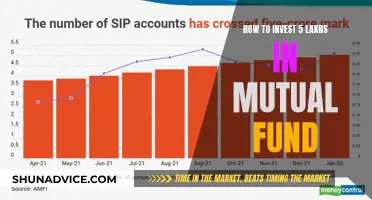
The TSP F Fund, also known as the Fixed Income Index Investment Fund, is a broadly diversified U.S. bond index fund. The fund uses a passive management (indexing) investment approach, designed to match the performance of the Bloomberg U.S. Aggregate Bond Index, a broad index representing the U.S. bond market. The F Fund provides broad exposure to U.S. investment-grade bonds, investing about 30% in corporate bonds and 70% in U.S. government bonds of all maturities. The F Fund is one of five core investment funds available in the Thrift Savings Plan (TSP), a direct-contribution retirement plan offered to U.S. government employees.
What You'll Learn
- The F Fund is a broadly diversified US bond index fund
- It tracks the Bloomberg US Aggregate Bond Index
- It has a higher rate of return than short-term securities
- It has a relatively low risk compared to other fixed-income investments
- It is subject to market, inflation, credit default, and prepayment risks

The F Fund is a broadly diversified US bond index fund
The F Fund, also known as the Fixed Income Index Investment Fund, is a broadly diversified US bond index fund. It is one of the five core investment funds available in the Thrift Savings Plan (TSP), a retirement savings plan offered to US government employees. The F Fund's objective is to match the performance of the Bloomberg US Aggregate Bond Index, a broad index representing the US bond market.
The F Fund provides broad exposure to US investment-grade bonds, investing about 30% in corporate bonds and 70% in US government bonds of all maturities. The Bloomberg US Aggregate Index, which the F Fund tracks, contained over 10,000 bonds as of November 2024. The F Fund itself held 13,334 notes and bonds as of December 31, 2023. Due to the large number of securities in the index, it is not feasible for the F Fund to invest in each security. Instead, it selects a large representative sample of various types of asset-backed, US government, corporate, and foreign government securities included in the overall index.
The F Fund is a passive management investment approach, meaning it aims to replicate the performance of the underlying index rather than actively selecting securities. This fund offers investors the opportunity to earn higher long-term returns compared to short-term securities like the TSP G Fund. However, it is important to note that the F Fund carries several risks, including inflation risk, interest rate risk, credit risk, and income risk.
The F Fund is suitable for investors seeking broad exposure to the US bond market and those looking for higher long-term returns. It is a good option for diversifying a retirement portfolio, as the prices of bonds and stocks don't always move in tandem. By including an allocation to bond funds like the F Fund, investors can reduce the volatility of their portfolio compared to holding only stock funds.
A Guide to Investing in 401(k) Mutual Funds
You may want to see also

It tracks the Bloomberg US Aggregate Bond Index
The TSP F Fund, also known as the Fixed Income Index Investment Fund, tracks the Bloomberg US Aggregate Bond Index. This index is a broad index representing the US bond market. As of 31 December 2023, the index included 13,334 notes and bonds.
The Bloomberg US Aggregate Bond Index consists of high-quality fixed-income securities with maturities of more than one year. The F Fund invests in a very diversified portfolio of high-grade (investment-grade) bonds, with about 30% in corporate bonds and 70% in US government bonds of all maturities.
The F Fund's investment objective is to match the performance of the Bloomberg US Aggregate Bond Index. The Federal Retirement Thrift Investment Board has chosen to invest the F Fund in an index fund that tracks this index. The F Fund's performance is evaluated based on how closely its returns match those of the index.
The Bloomberg US Aggregate Bond Index is designed to provide a broad representation of the US bond market. It includes investment-grade, fixed-income securities from various sectors, such as asset-backed, US government, corporate, and foreign government securities.
By tracking the Bloomberg US Aggregate Bond Index, the TSP F Fund provides investors with broad exposure to US investment-grade bonds. This diversification helps to lower the overall risk of investing in the F Fund compared to certain other fixed-income investments in the market.
SBI Bluechip Fund: Direct Growth Investment Strategy
You may want to see also

It has a higher rate of return than short-term securities
The TSP F Fund, also known as the Fixed Income Index Investment Fund, offers investors the opportunity to earn higher long-term returns compared to short-term securities like the TSP G Fund. This is because the F Fund is invested in a broad range of U.S. investment-grade bonds, providing investors with broad exposure to the U.S. bond market.
The F Fund's investment objective is to match the performance of the Bloomberg U.S. Aggregate Bond Index, which is a broad index representing the U.S. bond market. As of November 2024, this index included over 10,000 bonds, with a yield to maturity of around 3.9% and an average coupon of 2.6%. By tracking this index, the F Fund provides investors with the potential for higher returns over the long term.
The F Fund has delivered on this objective, with an average annual return of 3.8% from July 2005 to March 2024, outperforming the G Fund's average annual return of 2.4% during the same period. This demonstrates the F Fund's ability to generate higher returns compared to short-term securities.
The higher rate of return offered by the F Fund comes with a relatively low level of overall risk. The F Fund includes only investment-grade securities, and its diversified portfolio of high-grade bonds helps to mitigate risk. However, it's important to note that the F Fund does come with certain risks, including market risk, credit default risk, inflation risk, and prepayment risk. These risks are inherent in bond investing and should be carefully considered by investors.
By investing in the F Fund, individuals can take advantage of the higher returns typically associated with long-term bond investments while benefiting from the fund's relatively low-risk profile. This makes the F Fund a compelling option for those seeking to balance their investment portfolios and maximize their returns over the long term.
Quant Small Cap Fund: Smart Investing Strategies for Beginners
You may want to see also

It has a relatively low risk compared to other fixed-income investments
The TSP F Fund, also known as the Fixed Income Index Investment Fund, is considered to have a relatively low risk compared to other fixed-income investments. This is primarily because the F Fund includes only investment-grade securities. The fund's objective is to match the performance of the Bloomberg U.S. Aggregate Bond Index, a broad index representing the U.S. bond market.
The F Fund provides broad exposure to U.S. investment-grade bonds, investing about 30% in corporate bonds and 70% in U.S. government bonds of all maturities. The Bloomberg U.S. Aggregate Index, which the fund tracks, contains over 10,000 bonds, with an average maturity of 8.9 years and an average duration of 6.7 years. The fund's diversified portfolio of high-grade bonds helps to mitigate overall risk.
Compared to short-term securities such as the TSP G Fund, the F Fund offers the opportunity for higher long-term returns. However, it is important to note that the F Fund is subject to market and inflation risk. F Fund returns fluctuate with the bond market, and investors are exposed to the possibility of credit default and prepayment risk. Additionally, there is a risk that the F Fund's returns may not outpace inflation, resulting in a reduction in purchasing power.
When considering the risk profile of the F Fund, it is essential to understand the broader context of the bond market. The current environment of low interest rates may impact the potential for future returns. As interest rates rise, the value of existing bonds with lower yields decreases, and the F Fund, which holds bonds of various durations, is sensitive to these changes in interest rates.
In summary, while the TSP F Fund is considered to have a relatively low risk compared to other fixed-income investments due to its focus on investment-grade securities, it is not without risks. Investors need to carefully consider market conditions, interest rate trends, and the potential impact on their investments.
Investing in Qualified Opportunity Funds: A Comprehensive Guide
You may want to see also

It is subject to market, inflation, credit default, and prepayment risks
The TSP F Fund, also known as the Fixed Income Index Investment Fund, is a broadly diversified U.S. bond index fund. It is subject to market, inflation, credit default, and prepayment risks.
Firstly, market risk. The F Fund's returns move up and down with the returns in the bond market. This means that investors are exposed to the possibility of losses when bond prices fall. This is particularly relevant given that interest rates are currently at multi-decade lows, leaving less room for gains from further decreases in interest rates.
Secondly, inflation risk. Investors in the F Fund are exposed to the possibility that the interest payments on the bonds that comprise the index will not be enough to offset the reduction in purchasing power due to inflation. This is a significant risk, as the average U.S. inflation rate is around 3% per year.
Thirdly, credit default risk. F Fund investors are exposed to the possibility that the principal and interest payments on the bonds that comprise the index will not be paid. This could occur if a company or government's credit quality declines.
Lastly, prepayment risk. This is the probability that if interest rates fall, the bonds that are represented in the index will be paid back early, forcing lenders to reinvest at lower rates. This is more likely to occur when interest rates are low, as they are currently.
While the F Fund does carry these risks, it is important to note that the overall risk is relatively low compared to certain other fixed-income investments in the market. This is because the F Fund includes only investment-grade securities. Additionally, the F Fund has the potential to provide higher long-term returns compared to short-term securities such as the TSP G Fund.
Best American Funds: Where to Invest Your Money
You may want to see also
Frequently asked questions
The TSP F Fund is a broadly diversified U.S. bond index fund. It is a "passive management" investment fund designed to match the performance of the Bloomberg U.S. Aggregate Bond Index, representing the U.S. bond market.
The F Fund invests in a range of fixed-income securities, including U.S. government bonds and corporate bonds. It aims to provide broad exposure to U.S. investment-grade bonds.
The F Fund offers investors the opportunity for higher long-term returns compared to short-term securities like the TSP G Fund. It provides a relatively low-risk investment option as it only includes investment-grade securities.
The F Fund has historically provided higher returns than the G Fund, but with more volatility and periods of loss. It has a compound annual growth rate of 5.1% and has returned between 1.96% and 8.05% in the last year.
The F Fund carries several types of risks, including inflation risk, interest rate risk, credit risk, and income risk. These risks can potentially impact the value of the fund and the returns for investors.







